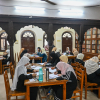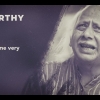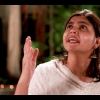The literary work is a deliberate creation of language which addresses readers through different formal configurations, which we call genres. Every work is oriented towards the reader/addressee through a particular arrangement of thematic and generic conventions which form the mode of address and the tone of the work.
Literary history is the narrative of intelligible, significant connections between literary works, related to their composition. It includes the generic or thematic conventions or chains of signs that writers in that language create or borrow from other mediums of expression, earlier times or other languages. Literary history gives an account of the role played by these conventions or sign-chains in the generation of individual literary works, in the process forming, extending or deviating from the conventions that comprise the literary tradition in that language. Writing a history of change in literary conventions is the task of literary historiography.
Literary tradition is peculiar to the language in which the work is written, because it comprises the linguistic and thematic conventions available across time in that language and building a literary tradition in that language. But a tradition of literary conventions and themes may also be shared by language-cultures that have come into contact with one another, as may be seen in the exchanges between the local languages of Hindustan and the different languages brought by the Muslim rulers, traders and saints who came and settled there. A common homeland may also lead to a sharing of cultural and linguistic practices, though later dispersal may have led to distinct cultures: the similarities between the Vedic and the Avestan language and rituals can serve as an example of this.
Literary history traces the journey of elements of form or content passed on within a literary tradition. This journey gives that tradition a concrete shape, and extends literary history beyond the record of the writing and publishing of books. We may take the story of Rama as an example of what Sisir Kumar Das (2004) calls an ‘inherited text’, which becomes part of the literary culture and is a source of elements of both theme and form. An example is the Paum Cariya, by Vimal Suri. This is written in the Jain Maharashtri or Arsa Prkrt language, in the 4th century AD. Paum, or Rama, is here portrayed as the ideal Jaina hero, thereby setting an example of behaviour for the followers of Mahavira. For example, as a Jaina hero he is a practitioner of ahimsa, and so in this story of Rama, it is Lakshman who kills Ravana. Elements common to the didactic charit can be seen in later charit texts written by those who followed what is loosely called the Bhakti movement across medieval India. Examples of this can be Tulsidas’ Ram Charit Manas, written mainly in Awadhi and telling the life of Ram to inspire his devotees, of whom Tulsi counts himself as one. Tulsi acknowledges his sources: Valmiki’s Ramayana and Bhavabhuti’s Uttar-ramcharit, which serves to explain his unique treatment of the commonly known themes and situations in keeping with his specific aim. Satinath Bhaduri’s Dhorai Charit Manas, written in Bangla in the 1950s, is modelled on Tulsidas’ Ram Charit Manas but tells the life of a poor low-caste Tatma living in the United Province of pre-independence India, who is first influenced by Gandhi and then joins the armed nationalists. Tulsi’s ‘medieval’ Ram Charit Manas is present in the literary, social and intellectual milieu of the author Satinath Bhaduri in the first part of the 20th century. It is simultaneously also available as a model for life practices and ways of acting and reacting to actual situations in the lives of the poor untouchables and low-caste people who are the protagonists of Bhaduri’s novel. Tulsi’s telling of Rama’s life makes Bhaduri’s novel possible, just as the existence of the Rama matter is necessary for its Jain re-interpretation in Paum Cariya, where the heroes of the so-called Hindu epic act in accordance with Jain religious principles.
Elements that are ‘inherited’ can be called ‘residual’—they are either thematic elements or generic markers that remain part of the literary tradition, and are used by writers working in that language across time. Besides, these residual elements also occur in works that share a literary culture, as we have seen in the case of the Rama matter. Other instances of this are the Greek myths, the Sanskrit kavya or itihasa, the Shah Namah or the Cankam poetry: a common fund of literary forms and themes derived from these ‘inherited’ texts exists in many different languages, due to cultural contact. The many feminist rewritings of the relationship between Rama and Sita in many Indian languages, or the travel of Ulysses/Odysseus across the literatures of the Europhone world, are cases of where residual thematic elements are used by later writers. In each case, the earlier works are repositories of chains of signs, thematic kernels or similar literary elements. Tracing the specific forms in which these inherited elements occur in texts across time and place, or within a literary ‘period’ or ‘movement’, literary history records the changing function of particular literary conventions and studies their relation to changes in form and theme.
Literary periods are thus units of time in which some trends, thematic and formal are said to be ‘dominant’ (Williams 1977). The poetry of Chhayavaad in Hindi, for instance, shared a common spoken register, a common attraction towards natural spoken rhythms of the language and a desire to assimilate the influence of English Romantic poetry with the tradition inherited from Sanskrit and from Hindi itself. But this did not prevent differences in aesthetic aims and poetic practices by individual writers. To take another example, the Romantic period in 19th-century European literature, is dominated by the outpouring of passionate intensity and the cult of the individual. This is a broad generalisation, with the specificities of each language-culture dependent on its own literary tradition and the historical circumstances in which the writer, his audience and the patron lived. So the characteristics exhibited by the poetry of German Romantics differs crucially from the poetry of the English Romantics; while the later English Romantics are both similar and different from the earlier/older poets thus described. The history of a ‘period’ is thus a record of change, which can be understood as the result of the interaction between the residual elements and the dominant elements of literary form in a given literary work.
A ‘historical study of a particular literary element would be located in a particular period, so that its use of residual and dominant elements, i.e., those related to the themes and forms popular or artistically respected at a particular time becomes clear.
When the changes and similarities in these elements are studied across time and space, i.e., both diachronically and synchronically, then we may speak of this as the study of a literary movement. Just as the dominant elements of a particular period serve to identify it, similarly, common aims and methods shared by writers whether in the same period or across time, whether in the same place or scattered, identify a movement. A literary movement therefore is not characterized by a unified period, but by a set of literary norms and usages. A movement is independent of time, and identified by sharing a common set of characteristics across time and space. The tenets of the Symbolist literary movement originating in French in the 19th century and spreading to the rest of Europe and America by the early 20th, is an example. The Negritude movement, begun by students of African descent from across the world, originated in Paris through the publication of the journal ‘Legitime Defense’ in 1921. Thereafter, it spread to the African continent, to Latin America, and the Caribbean islands. The common ground for this movement was the reclamation of themes and forms from oratures in African languages and their use in a context marked by the violence of colonisation and slavery, as a means of the assertion of African cultural identity, in Africa and among people of African descent dispersed across the world due to slavery.
The building of discernible connections between elements in literary works literary conventions draws attention to the formation of the literary tradition in the language. The author’s singular reception of this tradition is discernible in the particular work or body of work that she produces. The kernel around which a narrative of the history of literature may be written is the process of building repertoires of signification in and across different languages with a shared tradition. And the foremost example that comes to mind is the interweaving of concepts, forms and images that create the world of Bhakti in various Indian language literatures. A shaping influence upon the literary field is the pre-colonial contact between the languages and cultures of the subcontinent and the traders, saints and rulers from the world of Islam. The plurality of sources and their harmonization for both universal and particular characterize these few centuries which are formative of modern Indian culture during which a new language came into being. Shared characteristics—persisting in speaking truth to power and celebrating the uncompromising self-surrender to the power of love—recur from the south to the north-east and west to north, laying the foundations of each modern Indian language and its literature
Literary History in India
Individual Indian language literatures are produced through a dynamic relation between the shared Indian tradition, the local language and guest languages and cultures.
All scripted Indian languages have been formed and survive through the phenomenon of contact, whether intra-systemic, i.e. between local languages, or inter-systemic, i.e. between local and guest language-cultures. So ‘Indian literature’ in the singular is not the result of integration of each discrete language literature, but characterized as a descriptive category by plurality which results from contact. A history of literature of a single language, in all its written or spoken varieties and registers requires an understanding of repertoires of signification formed by the local and translocal stratifications and inequalities that language imposes and has to bear, since it is an instrument of life. To add to this, every ‘Indian’ language, has a vast variety of inherited texts, as discussed above. These factors contribute to a shared literary horizon.
A common periodization of Indian language literatures is possible, based upon the historical fact of plurality and the phenomenon of contact. For example, during colonial rule, a particular literary discourse travelled through intermediaries, like translators, literary periodicals etc., from the west. Having migrated to a new location, the literary discourse from the coloniser is differently inflected in different regional-cultural-linguistic configurations across the colony. In this act of circulation, certain commonalities mark each inflection given by a specific language and its nesting culture, thus spawning a new literary movement in the area of reception. An example may be the reception of European Romanticism in early 20th-century India, which introduced the germ of modernity into a number of Indian literatures. The literary movements of Chhayavaad (Hindi), Sabuja (Oriya), Navyakavya (Kannada), the movement in Ahamiya literature around the journal Jonaki are various results of this contact and its transcultural translation across space and language, within a specified period.
Here two kinds of contact are visible—an inter-literary contact between west and east and then an intra-literary contact between different Indian languages, resulting in a general similarity of response, manifested through unique local expressions.
This phenomenon is called intra-literary in the sense that Indian literature here is taken as a single system with multiple manifestations. The first part of this contact was underwritten by the spread of English as language and as literary discourse in the colony, which facilitated the colonized English-educated Indians’ access to English and non-English Romantic texts. The periodical literature of the second half of the 19th century provides a rich source for documenting this reception. As the site of the first city of the empire, Bengal was endowed with facilities for imbibing the ideas and ideals that circulated in England—these were then disseminated through the periodicals, and one strand of a variety of responses to these western influences produced what Raymond Williams (1977) would term a structure of feeling, which produced a figure like Rabindranath as an intermediary for a variety of European Romanticism.
I am not for a moment arguing that the contribution of indigenous traditions of thought, and literature did not play any role in this process—what I rather wish to emphasize is that the interaction of the western influences with different forms of indigenous influence helped to create a new horizon of expectation within which residual indigenous elements and dominant or contested foreign elements combined in various degrees to produce an emergent literary discourse. This was followed by the second level of contact that I referred to above—an intra-Indian literary contact, whereby the historical event of Rabindranath’s Nobel prize for literature increased the interest in the Bengali poet’s work, and in certain cases (like Nirala, one of the pioneers of Chhayavaad in Hindi) inspired the use of Rabindranath as a model, or, in certain other cases, led writers to turn against him (a phenomenon that occurred, naturally enough, in his own literary milieu, among younger Bengali poets). These literary-historical conditions framed the beginning of new literary movements in many Indian languages. Though each movement had its own name in its language, they are collectively described as modernism in Indian literatures.
The appearance of this modernism occurred in different, but connected phases in different Indian language literatures. Sisir Kumar Das (1991) indicated this pattern by the tools of prophane and metaphane. These can help towards forging a relational, comparative periodization of literary phenomena in Indian language literatures. For example, prophane (early assimilation) and metaphane (later assimilation) are concepts to explain the conditions of reception and absorption of elements from other literary systems. These conditions also depend upon what Durisin would call ‘hospitality’ i.e., the extent to which the receiving milieu is amenable to absorbing elements of the guest culture/literature. This is an illustration of the concepts that may be used to write a history of literature as the result of the relations of contact.
Whether we are writing the history of a movement or a period, the Indian language literatures are situated within a plural cultural field, and the inter-literary condition thus created directs our study and plays a role in it. Though written in many languages, Indian literature is ‘Indian’ because many of the languages share repertories of signification and a fund of literary conventions and generic markers. The conceptual tools needed to understand the singularity of Indian literary culture and write the histories of Indian language literatures must be grounded in this reality.
References
Das, Sisir Kumar. 1991. A History of Indian Literature, Vol. VIII 1900-1910, Western Impact, Indian Response. New Delhi: Sahitya Akademi.
———. 2004. ‘The Idea of Literary History’ in Literary Historiography, ed. Ipshita Chanda. Kolkata: Jadavpur University.
Durisin, D. 1984. Theory of Literary Comparatistics. Slovak Academy of Sciences.
Williams, Raymond. 1977. Marxism and Literature. Oxford: Oxford University Press.











